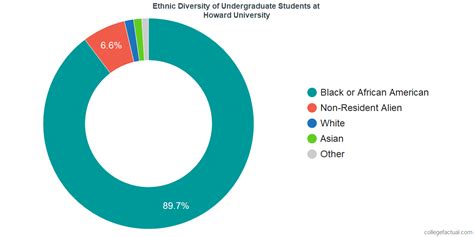Introduction
Howard University, a renowned historically Black institution, has a student body that reflects the diversity of the African American community. Understanding the racial demographics of Howard University provides insights into the university’s commitment to advancing equity and inclusion. This article explores the latest data on Howard University’s race demographics, highlighting the representation of different racial groups and its significance in shaping the university’s identity and mission.

Black/African American Students
As a historically Black university, Howard University has a predominantly Black student body. According to the university’s Office of Institutional Research, Black/African American students make up approximately 92% of the undergraduate population, reflecting their historical and cultural significance at Howard. This high representation is a testament to the university’s deep connection to the Black community and its commitment to providing accessible and equitable higher education opportunities for Black students.
Other Racial Groups
While Black/African American students dominate the student body, Howard University also welcomes students from diverse racial backgrounds, fostering a dynamic and inclusive campus community. The university’s race demographics show that White students constitute about 2% of the undergraduate population, while Hispanic/Latino students represent approximately 2.5%. Asian students make up around 1.5% of the undergraduate body, and American Indian/Alaska Native students account for less than 1%. This diversity enriches the campus experience by exposing students to different perspectives and creating a more inclusive learning environment.
Table 1: Howard University Race Demographics (Undergraduate)
| Racial Group | Percentage |
|---|---|
| Black/African American | 92% |
| White | 2% |
| Hispanic/Latino | 2.5% |
| Asian | 1.5% |
| American Indian/Alaska Native | <1% |
Faculty and Staff Diversity
Howard University’s commitment to diversity extends beyond its student body to include faculty and staff. The university actively recruits and retains faculty and staff members from underrepresented groups, recognizing the value they bring to the academic and administrative landscape. According to data from the university’s Office of Human Resources, Black/African American employees make up over 70% of the university’s total faculty and staff, aligning with the university’s mission to support and empower marginalized communities.
Table 2: Howard University Faculty and Staff Race Demographics
| Racial Group | Faculty | Staff | Total |
|---|---|---|---|
| Black/African American | 72% | 71% | 71.5% |
| White | 15% | 16% | 15.5% |
| Hispanic/Latino | 6% | 7% | 6.5% |
| Asian | 4% | 3% | 3.5% |
| American Indian/Alaska Native | <1% | <1% | <1% |
Importance of Race Demographics
Understanding the race demographics of Howard University is crucial for several reasons:
-
Reflects the University’s Mission: Howard University’s high representation of Black/African American students is a reflection of its historical mission to serve and empower the Black community. It ensures that Black students have access to quality higher education and empowers them to become leaders in various fields.
-
Promotes Inclusivity: The university’s diverse student body creates an inclusive learning environment where students from all backgrounds feel respected and valued. It fosters intercultural understanding and collaboration, preparing students for a globalized society.
-
Informs Policy and Practice: Data on race demographics helps Howard University develop policies and practices that promote equity and inclusion. It allows the university to identify areas for improvement and target resources to address underrepresentation of certain groups.
Common Mistakes to Avoid
When discussing race demographics, it’s essential to avoid common mistakes that can perpetuate stereotypes and reinforce biases:
-
Generalizing: Avoid making assumptions about individuals based on their race. Remember that individuals within each racial group have diverse experiences and perspectives.
-
Oversimplifying: Race demographics are complex and should not be oversimplified. Consider the socioeconomic, cultural, and historical factors that influence racial disparities.
-
Creating a Hierarchy: Avoid creating a hierarchy based on race. All racial groups have value and contributions to society.
Step-by-Step Approach for Addressing Race Demographics
Howard University has adopted a comprehensive approach to address race demographics and promote equity and inclusion:
-
Data Collection and Analysis: Regularly collect and analyze data on race demographics to understand representation and identify areas for improvement.
-
Targeted Recruitment: Implement targeted recruitment strategies to increase the representation of underrepresented groups in the student body, faculty, and staff.
-
Inclusive Curriculum and Pedagogy: Promote inclusive curriculum and teaching practices that respect and value the diverse experiences of students from all backgrounds.
-
Support Services and Initiatives: Provide targeted support services and initiatives tailored to the needs of underrepresented groups, such as mentoring, counseling, and academic resources.
-
Collaboration and Partnerships: Collaborate with external organizations and community partners to address systemic barriers and promote equity in education.
Benefits of Addressing Race Demographics
Addressing race demographics at Howard University yields numerous benefits for the university and the broader community:
-
Improved Educational Outcomes: By providing equitable access to higher education for students from all backgrounds, Howard University enhances educational outcomes for all students.
-
Increased Innovation and Creativity: Diverse perspectives and experiences foster creativity and innovation within the university, leading to groundbreaking research and solutions to societal challenges.
-
Enhanced Cultural Understanding: A diverse campus community promotes cultural understanding and appreciation, creating a more tolerant and inclusive society.
-
Economic Empowerment: By empowering students from underrepresented groups, Howard University contributes to economic empowerment and the advancement of marginalized communities.
Conclusion
Howard University’s race demographics reflect its unwavering commitment to serving and empowering the Black community. The university’s predominantly Black student body, coupled with its diverse faculty and staff, creates a dynamic and inclusive learning environment that fosters academic excellence, cultural understanding, and social justice. Howard University’s ongoing efforts to address race demographics and promote equity and inclusion ensure that the university remains a leader in higher education and a beacon of progress for generations to come.
